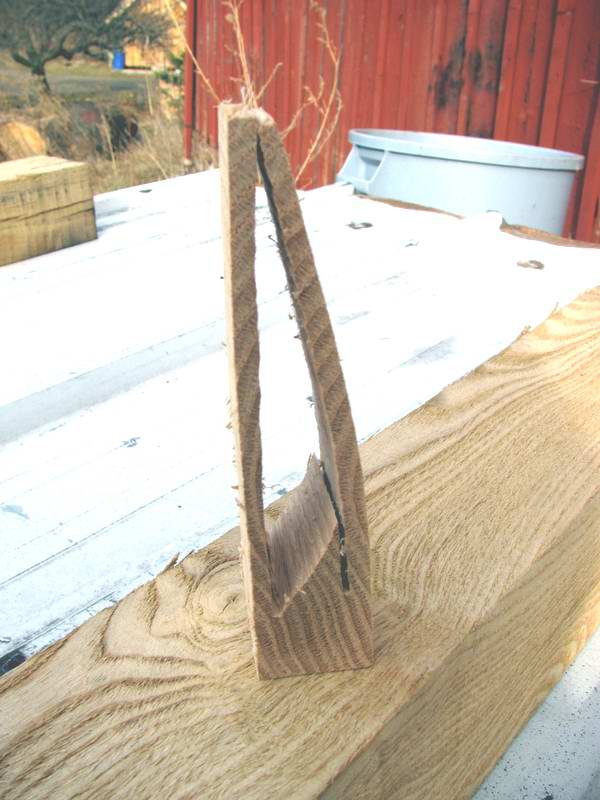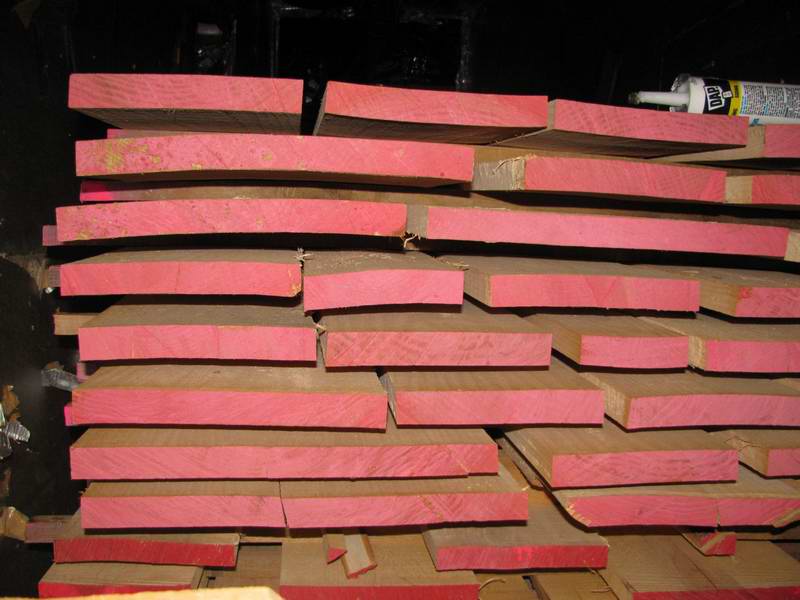Question
I finally decided it wasn't my logs, but my kiln drying that is wrecking all my super nice cherry. I have a Nyle 200 kiln with about 1500 bd ft of space. Is a twist indicative of any particular drying problem - too slow, too fast, bad conditioning? Too dry? I often sneak different species in the same load, and nothing twists like the cherry, so it's not the piles or the kiln carts.
Maybe part of the problem is the fact I got too dry, down to 3% on the cherry. Does this wreck the lumber or does it bounce back to normal when acclimated to 6-8%? This was the only time I got it so dry, but the twist is common. Does cherry just do this? I saw heavy to 1 3/16" to give room to joint, but my nice clear 14" wide boards get trashed every time!
My biggest problem in general is conditioning, as I can't simply throw the bucket of water on the floor, as my kiln is on a wood floor in my barn (covered by plastic). Is there a specific humidity to keep it at for a certain time? My Nyle kiln manual isn't so specific, though it's really old. I've been winging it and have lots of tension in all my lumber. (Pinching on the tablesaw blade is common.)
On the cherry problem, I did notice more cupping in my red oak than normal. This might be drying too slowly. The schedule seemed pretty speedy till the end.
Forum Responses
(Sawing and Drying Forum)
From contributor A:
You are drying too fast.
How did you measure 3% MC? It is virtually impossible to get that dry even in a steam kiln. You would have to run under 10% RH or 1% EMC. DH kilns cannot get that dry.
Twist is caused because the fibers are at an angle within the wood due to spiral grain (growth factor) or diagonal grain (sawing effect). Due to the low RH in air drying, compared to some kiln schedules (remember that it is not the schedule, but the actual conditions, that are the key), air dried lumber will usually be flatter.
Cup is also a natural defect, but it is greatly accentuated by adding moisture back to the dry surface fibers (starting the kiln at too high an RH) above 20% MC.
So, in your situation, what is the initial, actual RH for cherry and for oak and what is the initial MC?
Here is an article that I wrote which should help your understanding.
Warp in Drying
This might have to do with my schedule, as my kiln unit is quite old and I think it doesn't pull enough water when very dry. I talked with the Nyle guys and they had me turn off the compressor and turn up temps at the end, so maybe 5 days at 150 degrees with fans on to dry the core. I will read the article and see if I can glean more info.
Normally I air dry to 12-15% before putting in the kiln, but I still notice twisting in the cherry (only about 10-20% of boards do this). This load was wetter than usual, with cherry and oak around 30-40%. I used oven dry method, and didn't feel like my samples lost too much water too quickly, but I'm a hack, so possible. Think I was at 2-3% MC per day at most, as I was careful of the oak.
I can understand a log that might have some lean to it, but these were quite straight and forest grown. Seems to happen quite a bit in the wider planks (ones I was hoping to sell for a premium). I'm also curious if finishing my loads at 150 might impart more tension in the lumber, as when I'm machining it often seems to pinch the chop saw blade and the tablesaw blades.
After talking with Nyle, my theory is that my kiln chamber is probably leaky enough that all the water I added escaped rather quickly, and I continued to simply dry out the jacket, if I even got it to equalize at all. I bought a cheapo hygrometer today, and will restack the 1500 bd ft back in the kiln, and try to get it balanced while checking RH.
I do have a steam generator for a steam box, though it only holds about 2 gallons and is propane fired, so leaving it running scares me in the old barn. Thinking of adding that to my setup. Now that lumber is cool, it's supposed to equalize easier.
I need to figure out what RH to hold the lumber at what temp for how long to condition. In some of the archives 4-10 hours was mentioned for steam injection.
I'm worried I've been selling bad lumber for quite awhile. I think I've been helped by the fact that it's mostly air dried and not green. Green seems to case harden the worst in my setup, and this load was pretty wet. Right now I'm putting 6 five gallon buckets with 2 gallons in each with a towel for a wick. They dry up, so I thought it was going into the wood. I also wet the sides of the chamber down with a deck sprayer, as my floor can't have water dumped on it per instructions.
I know these crazy systems are terrible to figure out, as there are so many variables, and few actual meters to tell what is going on inside, but there isn't profit enough in what I'm doing to do it right. I'll keep trying through trial and error and hope my customers don't give up on me. I've sure noticed that when I've had to buy hardwood from the local retail store, their lumber is dead flat, and neither springs apart nor pinches the tablesaw blade. It's almost likes it's plasticated - they sure have it down to an art. My 2" stock is even worse!


Your most recent post points to excessively high RH when starting the kiln, as well as a bit of over-drying. You need to start the kiln and have conditions under 10 % EMC at all times. You need to realize that over half of the shrinkage occurs above 18% MC. As casehardening, a shrinkage defect, occurs above 45% MC, but is relieved gradually in air drying, the longer AD occurs, the less casehardening.
Curious on your comment, Gene, of having too high of a RH to begin with when drying. What RH is recommended to start with? I use the Nyle schedule of 70% compressor at 90 degrees until under 35-40% MC, I think, though I don't know what RH I was at actually. Like you said, it's actual conditions that matter. Hate to think of all the case hardened lumber I've been making.
Is it not possible to case harden air dried lumber then? We dry down to about 15% MC usually, so unless it happened to the lumber while air drying, it won't happen in the kiln at that point? You mentioned it occurs above 46% MC. Aren't some species like ash only around 40% MC when green? Can't case harden ash then?
Regarding warp, the outer fibers after air drying are around 12% MC in most of the USA. We need to avoid adding moisture back to avoid increasing warp. Therefore, the EMC at startup should not exceed 10%. This includes heating up too.
I bought a turkey fryer and have it pumping steam into the kiln and now the RH has come up to 55% at 115, which should give me 9% on the lumber jacket. Can't remember the EMC there... but this is 2-3% over target MC of lumber. I'll look this up in my manual when I get out there. Hard to get the RH up high enough with this goofy rig, but better than my old system.
Thanks for the all the input!
The key for conditioning is rapid addition of moisture to the shell at as high a temperature as possible. Also, the wood cannot have a shell to core MC gradient and all pieces should be within 2% MC to assure uniform relief. In many countries, conditioning is done in a separate chamber.